calsfoundation@cals.org
George Edward Fisher (1923–2003)
George Edward Fisher was a political cartoonist whose work influenced and helped define Arkansas politics for a generation. He created a series of visual metaphors and themes that were widely associated with the politicians he caricatured and became a part of Arkansas political folklore. Fisher focused primarily on political, social, and environmental issues.
George Fisher was born on April 8, 1923, near Searcy (White County) to Charles W. Fisher, a tree nursery owner, and Gladys Fisher. His mother died when he was five, and his father alone raised Fisher’s two brothers, sister, and him. Fisher grew up in Beebe (White County), where he attended school and started the Beebe Grammar School News.
Fisher’s father was an avid reader and encouraged his son’s interest in drawing. He suggested an idea for Fisher’s first published cartoon, a sketch lampooning Governor Homer Adkins.
Fisher attended Beebe College for a year while serving in the Army Reserves. He left college in 1943 after being called to active duty. While stationed in England, he attended drawing classes at the Municipal College of Art at Bournemouth and drew cartoons for his regiment’s newspaper. In Bournemouth, he met art student Rosemary Beryl Snook. While serving as an infantryman in the Battle of the Bulge, Fisher maintained a sketch diary of his fighting experiences. During the war, he developed an interest in folk music, which later led him and his wife to create the Rackensack Folklore Society, Pulaski County. After the war, in 1946, Fisher married Snook and returned to college.
His first cartooning position was with the West Memphis News, run by World War II veterans determined to fight the abuses of Arkansas’s machine politicians. At the time of his hiring in 1946, Fisher wrote news stories in addition to drawing cartoons. The paper’s staunch reformist stance led to threats of lawsuits from the local political machine.
When the West Memphis News closed in 1949, Fisher moved to Little Rock (Pulaski County) and started a commercial art service. At the urging of friends, Fisher approached the North Little Rock Times and offered to draw political cartoons for free. Times editor Robert McCord accepted the offer, and Fisher’s cartoons were an instant success. The Pine Bluff Commercial began using the Times’s cartoons, and the Arkansas Gazette used them in its Sunday editorial section. Fisher’s cartoons soon became a local fixture. In the 1950s, Fisher and his wife created a syndicated television show, Phydeaux and His Friends, featuring puppets they sculpted. The puppets appealed to children, and the show’s political satire delighted adults. Local political figures, including Governor Orval Faubus, made guest appearances. Although Fisher initially supported Faubus, he quickly concluded that Faubus was an opportunist. Fisher’s most famous Faubus cartoon showed the governor addressing a legislature of Faubus look-alikes in a biting commentary on his influence on state government.
In 1972, the Gazette published Fisher’s cartoons several times a week. By the time he was hired as the paper’s editorial cartoonist in 1976, Fisher’s name was synonymous with the Gazette’s. Many of his cartoon symbols have become icons. He popularized the farkleberry bush in an account of a bizarre meeting of Faubus with state highway workers. As the story goes, Faubus stopped at a site where workers were clearing brush to demonstrate how it should be done. He named all the native plants, including the obscure farkleberry.
Fisher created the beloved “Old Guard Rest Home” series. The cartoons depicted retired or politically defeated public figures lounging on the porch of an old house, their communal refuge. “Old Guard” members reminisced or gave their perspectives on political events while a shirtless Faubus presided. The “home” was modeled after Fisher’s cabin in Timbo (Stone County).
Fisher, concerned with Arkansas’s environmental heritage, lampooned Army Corps of Engineers policies. He launched a cartoon campaign protesting the corps’s damming of free-flowing streams in the 1960s. One cartoon showed two engineers looking down at a ruined channeled stream; the caption read, “God would have done it if he had the money.”
Visual symbols were key in Fisher’s cartoons. Bill Clinton was shown riding a tricycle, referring to his being elected the nation’s youngest governor. Clinton eventually “graduated” to a pickup. Gazette readers came to identify Governor Frank White with Fisher’s depiction of him munching a banana, a reference to White’s support of the 1981 creation science bill, Act 590. At the Farkleberry Follies, a satirical media revue inspired largely by Fisher’s work, White publicly presented Fisher with a real banana.
In the mid-1970s, Fisher began hiding his wife’s nickname, “Snooky,” in his cartoons. Finding “Snooky” became a popular game with readers. His wife died in 1983.
Fisher worked for the Gazette until the Arkansas Democrat bought its assets in 1991, after which he drew cartoons for the Arkansas Times. He died on December 15, 2003, of an apparent heart attack at his drawing board in his Little Rock home. Judi Woods, his longtime companion, found him there shortly after he had completed two cartoons for the Times. He is buried in Beebe Cemetery at Beebe.
For additional information:
Arkansas Gazette Project. David and Barbara Pryor Center for Arkansas Oral and Visual History. University of Arkansas, Fayetteville, Arkansas. Online at http://pryorcenter.uark.edu/project.php?thisProject=2 (accessed July 29, 2023).
Deere, Stephen. “Cartoonist for Gazette, George Fisher, 80, dies.” Arkansas Democrat-Gazette. December 17, 2003, p. 1B.
“Drawing Distinctions: The Life and Work of American Cartoonist George Fisher.” Special Collections. University of Arkansas Libraries. http://digitalcollections.uark.edu/cdm/landingpage/collection/GeoFisher (accessed July 29, 2023).
Fisher, George. All Around the Farkleberry Bush. Little Rock: Rose Publishing, 1967.
———. The Best of Fisher: Twenty-Eight Years of Editorial Cartoons from Faubus to Clinton. Fayetteville: University of Arkansas Press, 1993.
George Fisher Papers. Special Collections. Arkansas Arts Center, Little Rock, Arkansas.
George Fisher Vertical File. Special Collections. University of Arkansas Libraries, Fayetteville, Arkansas.
Parry, Janine A., and Dusty Higgins. “Arkansas’s Cartoon Campaign Advertisements, 1942–1970.” Arkansas Historical Quarterly 77 (Autumn 2018): 208–249.
John Deering
Arkansas Democrat-Gazette
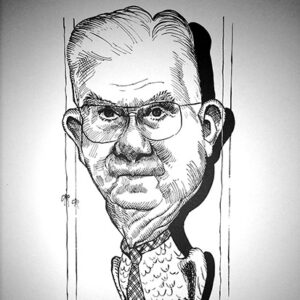 Douthit Caricature
Douthit Caricature  Leland Duvall Cartoon
Leland Duvall Cartoon 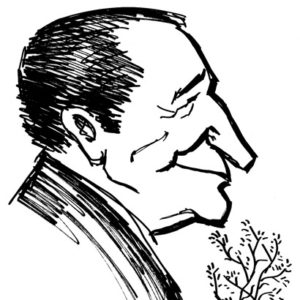 Farkleberry and Faubus
Farkleberry and Faubus 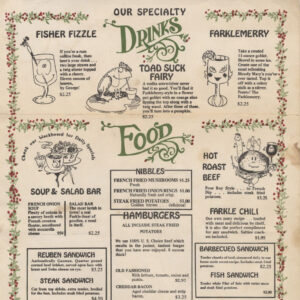 Farkleberry Menu
Farkleberry Menu  Farkleberry Menu Back
Farkleberry Menu Back 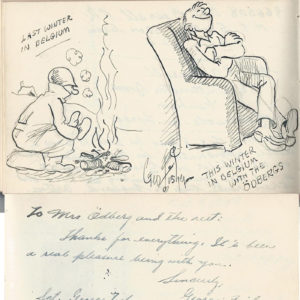 George Fisher WWII Cartoons
George Fisher WWII Cartoons 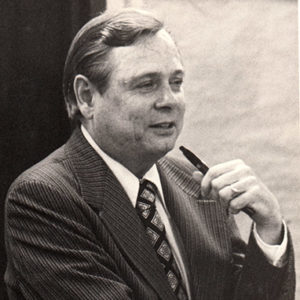 George Fisher
George Fisher 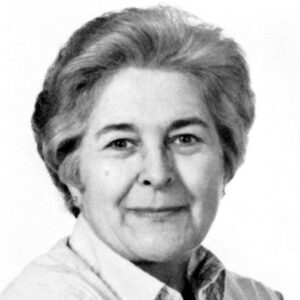 Rosemary Fisher
Rosemary Fisher 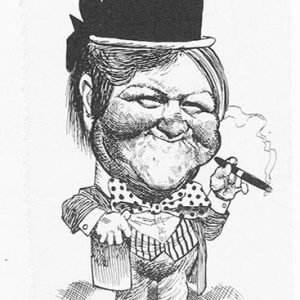 Jack Meriwether Caricature by George Fisher
Jack Meriwether Caricature by George Fisher 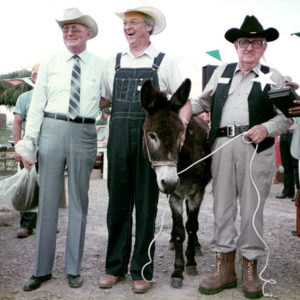 Old Guard Home Parody
Old Guard Home Parody 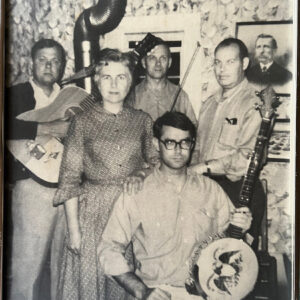 Rackensack Folklore Society, Pulaski County
Rackensack Folklore Society, Pulaski County 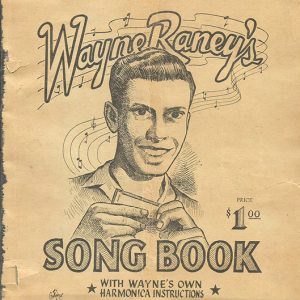 Wayne Raney Songbook
Wayne Raney Songbook 




Mr. Fisher was a friend. I worked with him a short time when he, in later life, was back in television. He was softspoken and kind. I met his father once; he too was kind. My father was in the House of Representatives for many years. I grew up knowing the folks who covered the legislature, newspaper, radio, and TV. George was very special. I am glad I knew him.